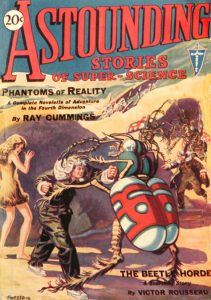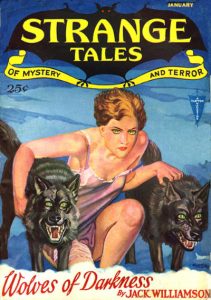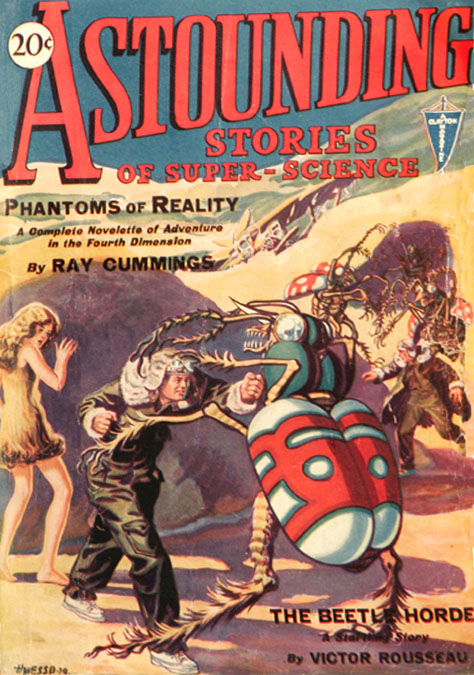 Except for scattered stories in the general-fiction pulps, Hugo Gernsback monopolized the early science-fiction market. This came to an end in late 1929 when Clayton Magazines, publisher of All Star Detective Stories, Clues, Cowboy Stories, Five-Novels Monthly, Flyers, Ranch Romances, and other pulps, jumped into the fray with Astounding Stories of Super-Science.
Except for scattered stories in the general-fiction pulps, Hugo Gernsback monopolized the early science-fiction market. This came to an end in late 1929 when Clayton Magazines, publisher of All Star Detective Stories, Clues, Cowboy Stories, Five-Novels Monthly, Flyers, Ranch Romances, and other pulps, jumped into the fray with Astounding Stories of Super-Science.
The brainchild of Harry Bates, editor of Clayton’s Wide World Adventures, the new magazine was meant to entertain rather than educate. “Astounding. As a name it lacked dignity, but no matter: it was gutsy and would compel attention, and it generally resembled Amazing and could be counted on to attract the eye of that magazine’s readers while pleasantly promising others that the stories would stun them.”
Alva Rogers writes in A Requiem for Astounding: “Astounding was unabashedly an action adventure magazine and made no pretense of trying to present science in a sugar-coated form as did, to some extent, the other two magazines. The amount of science found in its pages was minimal–just enough to support the action and little more. Lessons in science could be obtained in school or in text books; driving action and heroic adventure was what the reader of Astounding wanted. Interplanetary wars and space battles, hideous and menacing Bug Eyed Monsters . . . the courage, ingenuity and brains of a sngle puny man, or small group of men, pitted against the terrible might and overwhelming scientific knowledge of extraterrestrial aliens–with defeat the inevitable fate of the invaders: that was what set the reader’s pulse pounding. That was the type of story he could identify with, become the hero of. Action was the hallmark of Astounding Stories of Super-Science.”
The Clayton Astounding would run for 34 issues, its end brought on by William Clayton’s decision to buy out his business partner. Although the continuing economic depression certainly contributed to the publisher’s demise, his inability to raise enough funds to pay off his associate proved to be the Clayton Magazines ultimate downfall. Astounding Stories was cancelled following its March 1933 number, the result of a poor business decision.
 Beginning in 1931, Clayton also put out seven issues of Strange Tales of Mystery and Terror. Also edited by Harry Bates, Strange Tales was a direct competitor to Weird Tales. By paying its authors two cents a word, a rate that Weird Tales could not match, Bates was able to attract some of the leading contributors from “The Unique Magazine.” Although many fine stories appeared in Strange Tales, Jack Williamson’s short novel, “Wolves of Darkness,” and Hugh B. Cave’s “Murgunstrumm,” are perhaps the most notable works to run in the short-lived magazine.
Beginning in 1931, Clayton also put out seven issues of Strange Tales of Mystery and Terror. Also edited by Harry Bates, Strange Tales was a direct competitor to Weird Tales. By paying its authors two cents a word, a rate that Weird Tales could not match, Bates was able to attract some of the leading contributors from “The Unique Magazine.” Although many fine stories appeared in Strange Tales, Jack Williamson’s short novel, “Wolves of Darkness,” and Hugh B. Cave’s “Murgunstrumm,” are perhaps the most notable works to run in the short-lived magazine.
Like Astounding, Clayton’s Strange Tales of Mystery and Terror was canceled in 1933. Between 2003 and 2007, it was revived for three additional issues by Wildside Press.
Miracle Science and Fantasy Stories, published by former Clayton editor Harold Hersey, also appeared in 1931. Lasting just two issues, this science-fiction pulp published nothing of lasting significance.
To learn more about the images used in this post, click on the illustrations. Click here for references consulted for this article.







